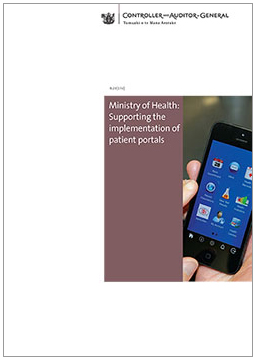The way to the future
 In our 2014 report Reflections from our audits: Our future needs – is the public sector ready? we reflected on how public services must change and adapt to help build the future we want and to meet new challenges. This includes considering how people might wish to access services, and how advancements in technology can play a part in making those services more accessible. These days, people are increasingly accessing services digitally – whether it’s interacting with an organisation, completing a transaction, or obtaining information.
In our 2014 report Reflections from our audits: Our future needs – is the public sector ready? we reflected on how public services must change and adapt to help build the future we want and to meet new challenges. This includes considering how people might wish to access services, and how advancements in technology can play a part in making those services more accessible. These days, people are increasingly accessing services digitally – whether it’s interacting with an organisation, completing a transaction, or obtaining information.
As part of its eHealth work programme, the Ministry of Health is looking at emerging technology, such as patient portals, to help people use health services more easily. Patient portals are secure websites that allow people to access their health information and interact with their doctor. Through patient portals, people can send secure messages to their doctor, order repeat prescriptions, and, in some patient portals, view lab results and doctors’ notes. Without the use of technology like this, general practices are at risk of being left behind.
Patient portals increase the options people have for consulting their GP by enabling them to do this online instead of through a traditional face-to-face consultation. This can be more convenient and efficient for them and their GP. Changing to meet modern requirements has the effect of ensuring that general practices remain relevant and sustainable.
Private companies develop and run patient portals, and primary health organisations (PHOs) and general practices buy access to them. To encourage uptake among practices and the public, the Ministry has been working with other organisations to support their implementation and we’ve published a report that looks at how well it’s done this. (Collaboration is something our Office encourages – check out this recent blog post about how local authorities are working with others to address water management challenges.)
Working effectively with the health sector helped the Ministry to identify and address reasons why some general practices were reluctant to implement patient portals. For example, concerns about the cost to implement patient portals or safety and privacy. Some of the Ministry’s initiatives to address doctors’ concerns included:
- providing some funding and financial advice;
- preparing guidelines to support PHOs and general practices;
- appointing eHealth ambassadors to raise awareness and interest among doctors and provide guidance and support to them; and
- running awareness campaigns for general practices and the general public.
This work has helped the number of general practices offering patient portals to people more than double since June 2015.
The number of people signing up for a patient portal at their general practice has also more than doubled since June 2016. There were 233,839 registrations between June 2016 and June this year, taking the total patient portal users to 407,049.
This increased uptake in the use of patient portals is an encouraging sign that people do want to change how they interact with their doctors and access their health information. Since starting our performance audit about patient portals, I’ve joined up. I really appreciate the convenience of ordering my repeat prescription and seeing my tests results online and being able to discuss matters with my doctor in a secure environment before deciding whether I need an appointment.
Through our work, we’re seeing many examples of how public organisations in both local and central government are using technology to deliver services to New Zealanders. We’ll be publishing some reports on this topic in the coming months, so keep an eye out for them.
What are some of the services that you access and use online? We’d like to hear about your experiences in the comments section below.
